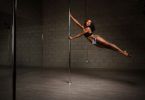With the Olympics expanding its sports repertoire, many wonder if pole dancing in the Olympics 2028 could become a reality. Sports like cricket, lacrosse, and squash have secured their spots, leaving pole dancing enthusiasts to ponder the competitive future of this growing discipline.
There has also been a long debate over where pole dancing could evolve into a fully-fledged, sustainable competitive sport, possibly seen at the Olympic level. With the increasing popularity of the activity, what is the competitive future of pole like?
Today you will not find odds on pole dancing at legal betting sites. And it’s not about which betting platform you choose or what payment system you use – browse Paypal betting sites UK for instance. You will find that many artistic sports around like synchronized swimming, figure skating and artistic gymnastics have become so mainstream that bookmakers commonly price up markets for the outcomes of major competitions. They all had to work their way up the ladder to reach events like the Olympics. Can pole dancing follow suit?
The Journey of Pole Dancing as a Competitive Sport
Pole dancing has come a long way from its origins, transitioning into a respected competitive sport. Governed by the International Pole Sports Federation (IPSF), the sport has already seen major milestones:
- Hosting the first World Championships in 2012.
- Earning “observer status” from the Olympic Committee in 2017.
- Aligning with the World Anti-Doping Agency (WADA) to build credibility.
While pole dancing has progressed in the competitive arena, the road to Olympic inclusion remains steep.
Overcoming Stigma and Gaining Recognition
One of the biggest challenges for pole dancing is overcoming the stigma tied to its past. The International Pole Sports Federation has worked tirelessly to position pole dancing as a fitness-driven, desexualized sport, but broader acceptance is still a work in progress.
For pole dancing to make it to the Olympics 2028, it must meet rigorous criteria, including:
- Expanding the number of national federations supporting the sport.
- Promoting inclusivity and accessibility across genders and age groups.
- Demonstrating global appeal through widespread participation.
Why Pole Dancing Deserves a Spot in the Olympics
1. Established Competitive Framework
The IPSF’s World Championships showcase pole dancing’s athleticism and artistic merit. Athletes from nations like Ukraine, Brazil, and Japan demonstrate exceptional skill, proving pole dancing is more than just a recreational activity.
2. Innovative Disciplines
Variations such as artistic pole, para pole, and ultra pole have broadened the sport’s appeal. These disciplines cater to diverse audiences and emphasize creativity, inclusivity, and physical strength.
3. Grassroots Growth
Youth participation in pole dancing is surging. The sport’s health and fitness benefits have attracted children and young adults, helping to rebrand pole dancing as a modern, empowering discipline.
What Needs to Happen Before 2028
For pole dancing to be part of the 2028 Olympics, these key steps must occur:
- Building National Support: Encouraging more countries to establish federations and host local competitions.
- Media and Sponsorships: Securing coverage to raise awareness and funding.
- Structured Competitive Events: Creating regular, high-profile events to sustain momentum and attract athletes.
- Changing Perceptions: Promoting the sport as a legitimate, inclusive, and athletic pursuit.
Positives Ahead
The established World Championships attract highly skilled athletes from countries like Ukraine, Japan, Brazil, USA and Mexico and it shows that pole dancing has a big competitive future.
The more the World Championships are promoted, the stronger the sport should get, and better coverage through the media and sponsorship can help drive competition and the prize money would reward athletes for their dedication of hard work and time.
However, it is at the national and local levels that things need to expand in terms of competitiveness. Pole dancing needs to spread its wings, pushed by new federations to create a long-term, structured series of regular, recognizable events.
The more work that’s done at the grassroots to further boost the already increasing influx of interest from children taking up the sport would be amazing. The fact that young people are drawn to the sport, with its health and fitness benefits, reflects a new, fresh and positive image of pole dancing.
The Future of Pole Dancing in the Olympics
While challenges remain, the momentum behind pole dancing as a competitive sport is undeniable. With increased global support, strong governance, and ongoing efforts by the IPSF, pole dancing could achieve Olympic recognition by 2028 or beyond.







